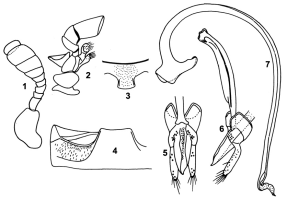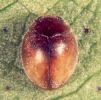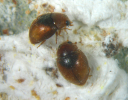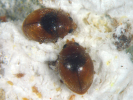Scientific name
Nephus regularis (Sicard)
Taxonomic position
Coleoptera: Coccinellidae: Scymninae: Scymnini
Diagnosis
Length 1.6-1.8 mm, width 1.2-1.4 mm. Form short oval, moderately convex. Head and pronotum yellowish brown. Elytra light yellowish brown, area along basal margins and suture darker, often with
a distinct dark patch. Antenna (Fig. 1) 10-segmented. Maxilla (Fig. 2) with terminal segment
cylindrical / parallel-sided, apical margin obliquely truncate. Prosternal process (Fig. 3) broader than long, without carinae and finely punctate. Postcoxal line (Fig. 4) incomplete, parallel to posterior margin of first abdominal ventrite for up to 4/5 th of its length and then very slightly recurved, area enclosed by postcoxal line with evenly distributed punctures, slightly smaller near line. Male genitalia (Figs. 5-7) as illustrated, median lobe of tegmen slightly asymmetrical. Pang & Gordon (1984) provided a redescription of this species with illustrations of the male genitalia.
 Figs. 1-7. Nephus regularis: 1. Antenna; 2. Maxilla; 3. Prosternal intercoxal process; 4. Postcoxal line on abdominal ventrite 1; 5-7. Male genitalia: 5. Tegmen, ventral view; 6. Tegmen, lateral view; 7. Sipho. Figs. 1-7. Nephus regularis: 1. Antenna; 2. Maxilla; 3. Prosternal intercoxal process; 4. Postcoxal line on abdominal ventrite 1; 5-7. Male genitalia: 5. Tegmen, ventral view; 6. Tegmen, lateral view; 7. Sipho.Images

 Adult Adult

 Adults feeding on Coccidohystrix insolita (Green) on egg plant Adults feeding on Coccidohystrix insolita (Green) on egg plant
Distribution
Widespread in India (Andhra Pradesh; Assam; Karnataka; Madhya Pradesh). Pakistan.
Prey / Associated habitat
HEMIPTERA: Aleyrodidae: Aleurodicus dispersus Russell. Aphididae:
Aphis gossypii Glover, Brevicoryne brassicae (Linnaeus), Lipaphis pseudobrassicae
(Kaltenbach) (as L. erysimi (Kaltenbach)), Rhopalosiphum maidis (Fitch). Coccoidea:
Coccidohystrix insolita (Green), Ferrisia virgata (Cockerell), Maconellicoccus hirsutus (Green), Nipaecoccus (as Pseudococcus) filamentosus (Cockerell), Planococcus
minor (Maskell) (as P. pacificus Cox), Pseudococcus sp., Pulvinaria (as Chloropulvinaria) polygonata Cockerell, Saccharicoccus sacchari (Cockerell);
associated with Chorizococcus sp. Commonly associated with mealybug and spiralling whitefly infestations on Bauhinia purpurea, brinjal, guava, gliricidia, mango, Boehmeria, etc.
Seasonal occurrence
Present throughout the year in and around Bangalore, usually in small numbers (Puttarudriah
& Channabasavanna, 1957); particularly active during June-October.
Natural enemy
Homalotylus quaylei Timberlake (Hymenoptera: Encyrtidae).
References
- Chelliah, S. 1965. The male genitalia of a few predaceous coccinellids (Coleoptera:
Coccinellidae) of South India. Indian Journal of Entomology, 27: 165-167.
- Pang, X. & Gordon, R.D. 1984. Lectotype designations and new synonymy in Oriental Scymnini (Coleoptera: Coccinellidae). The Coleopterists Bulletin, 38(2): 131-135.
- Puttarudriah, M. & Channabasavanna, G.P. 1955. Beneficial coccinellids of Mysore-II. Indian Journal of Entomology, 17: 1-5.
- Puttarudriah, M. & Channabasavanna, G.P. 1956. Some beneficial coccinellids of Mysore. Journal of the Bombay Natural History Society, 54: 156-159.
- Puttarudriah, M. & Channabasavanna, G.P. 1957. Notes on some predators of mealybugs (Coccidae, Hemiptera). The Mysore Agricultural Journal, 32: 4-19.
- Rawat, R.R. & Modi, B.N. 1969. Record of some predacious beetles on Coccid, aphid and mite pests from Madhya Pradesh. Indian Journal of Agricultural Sciences, 39: 1057-1060.
|